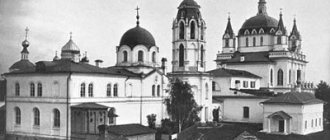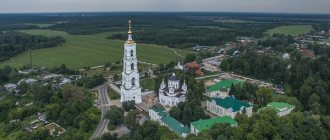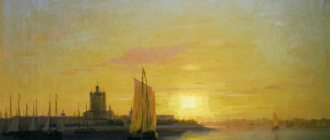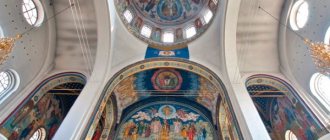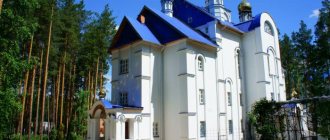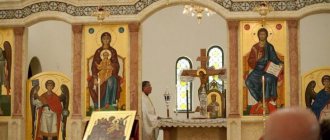| Moscow Church of the Resurrection of the Word on the Assumption Vrazhek |
Moscow Church in honor of the Resurrection of the Word (renovation of the Church of the Resurrection of Christ in Jerusalem), on the Assumption Vrazhek
(Central Deanery of the Moscow Diocese)
- Thrones: Resurrection of the Word (main), prophet. Elisha and St. Nicholas
- Address: Russia, 125009, Moscow, Bryusov lane, 15/2 (in 1962-1994 - Nezhdanova street)
- Directions: metro stations “Okhotny Ryad”, “Pushkinskaya”, “Tverskaya”, then on foot
- Phones: total. questions, schedule +7 (495) 629-6616, duty. priest +7 (915) 218-7199
- Official site:
- On the map: Yandex.Map, Google map
Once upon a time, between Nikitskaya and Tverskaya streets there was a deep, long ravine, next to which a wooden church in honor of the Dormition of the Blessed Virgin Mary had long existed.
From the name of the temple, this place in Moscow (or, as they used to say in the old days, “tract”) received the name “Uspensky Enemy” (ravine). This tract was the oldest in the so-called “White City” of Moscow. The temple was first mentioned in 1548. The existing stone temple was built in 1634 on the site of a wooden one that burned down in 1629.
Since 1620, there was a temple of the prophet nearby. Elisha, built in memory of the meeting of Tsar Mikhail Feodorovich with his father Patriarch Philaret, who was returning from Polish captivity. The temple burned down in 1812 and was restored as a chapel to the Church of the Resurrection in 1820.
The refectory and bell tower were rebuilt in 1816-1820, and the bell tower was rebuilt again in 1897.
In the 1930s the temple did not close, but the bells were removed.
In 1963-1964, 1979, 1982-1986. Restoration work was carried out in the temple.
Church of the Resurrection of the Word today
The Church of the Resurrection of the Word in the city of Moscow bears its name in honor of the celebration of the construction of the famous throughout the Orthodox world Jerusalem Church of the Holy Sepulcher by the Holy Emperor Constantine the Great in the middle of the 4th century, erected on the real historical site of the crucifixion and burial of Jesus Christ.
For a long time, this place of greatest suffering was desecrated by a pagan temple, until the Holy Empress Helena found the Cross of the Lord, after which the Church of the Resurrection of Christ in Jerusalem was erected and consecrated here, which became a symbol of the revival or renewal of the main Christian shrine and the spiritual life of the entire church community.
In memory of this event, churches are erected throughout the Christian world, where the patronal feast is solemnly celebrated with the rite of Easter service.
There are several such temples in the capital, one of which is located in the Assumption Vrazhek, that is, on the site of a deep ravine. Nearby there was a wooden church of the Assumption of the Mother of God, from which the name of the area in this part of the White City and the ancient ravine came.
In the 16th century, this tract was filled up, and in its place a lane arose, which was later named in honor of the nobleman Jacob Bruce, the governor-general of Catherine's era.
In the 17th century, several monastery cells were built at the temple for poor old women.
In the 18th century, the temple was actively patronized by Moscow Prince Gagarin, whose funds were used to repair the roof and renovate the church. In 71, a terrible plague epidemic in the city led to the death of all the priests of the temple, and 2 years later there was a severe fire, after which the monastery had to recover for quite some time.
It is noteworthy that the temple has never been closed since its foundation. On the contrary, shrines and icons were transferred to the church from temples and cathedrals that were closed in the vicinity. During the years of Soviet atheism, the bells were removed from the church, which were returned to the belfry only in the 90s.
Metropolitan Pitirim of Volokolamsk served here for more than 4 decades, becoming the confessor of the Moscow creative elite. Many artists, artists, writers and scientists flocked to his sermons and solemn services.
Today, the historical building not far from the Kremlin is recognized as an architectural monument of national significance.
During the years of the atheistic regime
Moscow old-timers know that during all the decades of total atheism, which during the years of Soviet power became an important aspect of state policy, and the anti-religious struggle associated with it, the Church of the Resurrection of the Word was one of those few churches that did not cease its activities. The schedule of services in Bryusov Lane did not change either, since their entire annual and daily cycle was performed in accordance with church canons.
Many are surprised that in the capital of the communist state, literally a stone's throw from the Kremlin, where its government met, all these years there was a church, which, in accordance with the propaganda clichés of the time, was nothing more than a “hotbed of obscurantism.” The question inevitably arises: what saved the temple on Bryusov Lane from destruction, when many Moscow shrines were barbarically blown up or converted for household needs?
Architect, exterior decoration, architectural ensemble
The Church of the Resurrection of the Word was built in the typical architectural tradition of the 17th century townsman churches in the form of a pillarless, single-domed quadrangle. From the original idea of a 5-domed white stone church, only a small 2-light quadrangle and a 3-part apse remain in the modern structure.
The walls of the building are decorated with semicircular niches with decorative zakomars, a strict patterned cornice and a columnar belt with large kokoshniks, corner pilasters with semi-columns. The refectory with 3 semicircular aisles is decorated at the corners of the side facades with rusticated projections, pilasters, porticoes and pediments.
The general proportions of the building of the classical style and the rhythmic, unusual design of the windows speak of the experience of the architect, whose name history has not preserved to this day. The window openings of the church are decorated with very modest platbands, a blank cylindrical drum on a solid belt with columns without windows, decorated with arcature.
The bell tower of the temple with a spacious 4-sided 2nd tier and a small dome in its modern form was rebuilt at the end of the 19th century to replace the rotunda with a Baroque spire, which was caused by the need to house the donated 327-pound bell. Small gatehouses are attached to the lower tier on both sides.
The walls of the temple, plastered and painted in reddish shades with white trim, contain images of Saints, which are regularly decorated with fresh flowers and candles. The fence and gates of the monastery have remained unchanged since the end of the century before last.
Current state[edit]
The temple is located in the quarter where the creative intelligentsia of the capital has always lived: the House of Composers and the House of Artists are nearby, and the Conservatory is within walking distance. Therefore, the parishioners of the Temple were people of art and science, writers and public figures, actors and directors. In Soviet times, in the church one could see singer Ivan Kozlovsky, actors Innokenty Smoktunovsky and Vladimir Zamansky, Russian opera singers the Pirogov brothers, theater director and actor Konstantin Stanislavsky, opera artist Sergei Migai, opera singer Antonina Nezhdanova, Bolshoi Theater soloist Maria Maksakova and many other cultural and artistic figures, largely thanks to whom the temple was not closed during the difficult Soviet times for the Church.
Currently, at the temple there are: children's and adult Sunday schools, photography courses, courses for studying the Church Slavonic language, etc.
Description[edit]
The building of the temple (a pillarless, single-domed quadrangle) is typical of a “street” church and is a typical example of a small townsman church of the 17th century. Its walls are completed with decorative semicircular zakomars with niches; modest window frames, corner pilasters with half-columns, a cornice with a strict profile, a columnar belt on a blind, windowless, drum of the chapter - all the architectural details of its decoration. Only the general proportions and the design of the window frames indicate that the temple was built by an outstanding and experienced architect.
From the original composition of the building, only a small double-height quadrangle of the temple and a three-part apse have survived, and the wide two-aisle refectory in the classicist style and the bell tower, adjacent to the west, were erected in 1816-1820. The once five-domed quadrangle of the temple retained the completion of the walls with a wide entablature with a belt of large kokoshniks and a cylindrical drum of the central chapter, decorated with arcature. The refectory with oval-shaped aisles is decorated on the side facades with rusticated risalits at the corners with pilaster porticoes, completed with pediments.
The opening of the old (white stone) wall of the temple was done by restorers on the southern wall of the temple.
The interior of the main temple (the height from the floor to the top of the vault is about 15 m) is illuminated by two tiers of windows. The walls and vaults are covered with oil painting, which was renewed several times, but basically preserves the composition, apparently dating back to the last third of the 19th century. The vault is decorated with stucco and painted ornaments in the style of 1870-1880. The existing white and gilded carved iconostases date back, as far as one can judge from their style, to the very end of the 19th century.
History of construction
The very first mentions of the Resurrection Church, still a wooden one, on the Assumption Vrazhek date back to the middle of the 16th century.
A terrible fire in the first half of the 17th century led to the destruction of all buildings in this area. Therefore, construction of a stone church soon began, consecrated in 1634 at the request of the temple priest and rector Matthew to Patriarch Joasaph.
By that time, the church had 3 altars:
- In honor of the prophet Elisha, it was consecrated in memory of the return of Patriarch Philaret, father of Tsar Michael, from Polish captivity.
- Chapel in honor of St. Nicholas the Wonderworker.
- Throne of Martyr Paraskeva.
The church building stood unchanged for more than 2 centuries, and then at the beginning of the 19th century the belfry and refectory part of the temple were rebuilt, and a little later the window openings were expanded, which were plastered with keel-shaped frames in the old Russian style.
By the end of the century before last, the architect Alexander Meissner rebuilt the upper floors of the pseudo-classical bell tower to accommodate a larger bell donated to the temple, which can be seen in the modern building. In the 30s of the last century, all the bells were removed, but the temple continued its work, thanks to the intercession of famous cultural and artistic figures.
In the middle of the century, and then in the 80s, repair and restoration work was carried out. And in March last year, the restoration of wall frescoes and ornaments on the vaults was completed, and the medallions above the window openings were also restored.
Silenced and revived bells
Nevertheless, the anti-religious campaigns of Soviet times did not bypass the temple in Bryusov Lane. All these years, the schedule of his services continued to notify parishioners that they were being held in full (and this, of course, is a gratifying fact), but the evangelist who called for them fell silent for many years. By order of the city authorities, the unique bells, which still remembered Ivan the Terrible, were removed and sent for melting down. Since then, the church bell tower, having lost its main purpose, has become a purely decorative element.
The festive chime resounded again on Bryusov Lane only in February 2008, when the main bell, consecrated shortly before, and named “Archangel Michael”, was solemnly raised to its bell tower. Since then, his voice can be heard on all canonical Orthodox holidays.
Interior decoration
The height of the interior of the temple is 15 m. The interior was renovated several times, maintaining the basic composition.
The walls and vault with stucco decorations and ornaments are painted with oil frescoes. During the restoration work, ancient paintings were discovered in the quadrangle and the altar, hidden from view by a layer of paint. The fresco depicting the event of the Lord's removal from the cross was completely restored. The remaining fragments of the lost painting have been partially restored.
The walls of the Church of the Resurrection of the Word in Moscow are decorated with beautiful paintings
The room is illuminated by 2 rows of windows. Ancient icons are skillfully decorated with carved vestments and icon cases. The carved white and gold main iconostasis corresponds to the style of the end of the century before last. The iconostasis of the side Nikolsky chapel is prefabricated, made in the period of the late 17th - early 19th centuries.
Shrines and relics of the temple
In the richly decorated icon case on the left side of the temple you can see the ancient image of the Mother of God of the Seek of the Lost in a rich silver robe with a lot of donated jewelry and jewelry that received miraculous help.
The Mother of God is depicted on this icon with her head uncovered, which symbolizes the cover she gave for the salvation of sinners. A huge number of pilgrims and petitioners come here every day.
According to ancient legend, this icon was preserved by a pious parishioner of the Church of the Nativity, a widower who constantly prayed for the well-being of his daughters. In a dream, he was ordered to give the icon to the temple, which he immediately fulfilled.
Later, the church was looted by Napoleonic soldiers, and the miraculous image was abandoned and split. Restorer artists were able to restore the holy icon, which was transferred from the Palashinsky temple in the 30s of the last century.
It is worth paying attention to the rare miraculous image of Spyridon of Trimifunt, located in the main part of the temple in a rich carved robe, to the right of the icon of the Savior. In the center of the icon there is a small ark, which reveals a particle of holy relics.
In the left aisle of the church there is an ancient Mozhaisk icon of the 16th century depicting St. Archbishop Nicholas of Myra of Lycia with a particle of miraculous relics. Revered shrines of the 17th-18th centuries with images of the prophets Elisha and Elijah with their lives can be seen on the right side.
An ancient icon of the 17th century with the image of Justin the Philosopher is installed in the iconostasis of the St. Nicholas chapel. There is a revered image of Anna Kashinskaya with particles of her holy relics in the temple.
In the main altar between the windows there are revered images of Saints Cyril and Methodius, Grand Duke Vladimir and Princess Olga, made by the famous master of church painting Nesterov.
History of the temple
The first mention of the temple on the Assumption Vrazhek dates back to 1548; on Peter’s plan of Moscow the building was designated in 1596-1598. At that time, a wooden church stood on this site, built in honor of the holiday of the same name.
In 1629, due to a major fire, the wooden building was completely burned down. Local residents immediately began construction of a stone cathedral. Due to an incorrect reading of the chronicle, for a long time April 10, 1629 was considered the date of the start of construction. The book itself indicates the date of the fire, after which construction began in a short time (most likely in the summer of the same year). It was completed in 1634: on July 4, the priest asked in a letter for the blessing of 2 thrones.
At the beginning of the 19th century, the bell tower and refectory were rebuilt; in the second half of the century, the window openings were expanded and framed in the Russian style. At the end of the century, the upper tiers of the bell tower were replaced: the new ones were made in a pseudo-classical style according to Meissner's design. The reason for the restructuring was the donation of a bell that was too large. The temple has survived in this form to this day.
It is noteworthy that in the Soviet Union the cathedral was not demolished or even closed - they were only deprived of the bells. This became possible thanks to the intercession of famous artists who lived on Nezhdanova Street. They were also his parishioners: they note that singers brothers Pirogov and Kozlovsky, actors Smoktunovsky, Zamansky and Stanislavsky, opera artists Migaya and Nezhdonova, soloist of the Bolshoi Theater Maksakova and many others came to the services. Icons and shrines from closing churches were transferred to the temple for safekeeping.
Restoration work was even carried out - in 1963-1964, 1979 and 1982-1986. The last restoration was completed only in 2021: 40 paintings on the vaults and walls, 2 medallions above the windows were restored. Today the temple is an architectural monument and is protected at the state level.
The temple is made in a manner typical for a small townsman temple of the 17th century. Its building was a pillarless, single-domed quadrangle. There were few decorative elements: modest window frames, corner pilasters, a patterned “belt”.
Little has survived from the first version: a 3-part apse and a two-height quadrangle. The refectory and bell tower were built only at the beginning of the 19th century; during subsequent restoration work, the southern wall was opened and elements were added. Modern wall paintings and stuccoes most likely date back to the end of the 19th century.
The outside walls are also decorated with images of saints. Many people regularly receive flowers and candles.
Chapels and shrines
In total, there are 3 limits in the temple: the Resurrection of the Word (main), St. Nicholas the Wonderworker (northern), the Prophet of the Yenisei (southern). The latter was moved here from a church that closed nearby several centuries ago.
The shrines of the temple include:
- Icon of the Mother of God “Seeking the Lost.” Moved in 1937 from the Church of the Nativity of Christ on Palashi. It is believed that it was painted around the 18th century, but until the beginning of the 19th century it belonged to a Moscow family. According to legend, one of the family members gave the icon as a gift when his prayers for the well-being of his daughters were heard and fulfilled. The icon is located in the icon case to the left of the iconostasis and is one of several most famous in Moscow. Before her they pray for recovery and healing from vices (especially drunkenness), for a happy marriage and well-being in the family.
- Icon of St. Spyridon of Trimifunt with a particle of his relics. This rare Moscow shrine is located in the main aisle on the right. Saint Spyridon was considered the patron saint of the poor and disadvantaged, merchants who conduct business honestly, and the sick. It is believed that people who are left without any means and those who may lose their housing can turn to him for immediate help.
- Icon of St. Nicholas of Mozhaisk with a particle of his relics. This is the oldest image: it was painted at the end of the 16th century. Located in the left aisle.
- Icons of the Prophet Elisha and Saint Elijah the Prophet (XVII-XVIII centuries, located in the right side chapel), icon of the Holy Martyr Justin the Philosopher (XVII century, updated in the 19th century, located in the iconostasis of the left side side chapel).
Also in the cathedral there are icons of the Mother of God (“Kazan”, “Smolensk”, “Bogolyubskaya”, “Iverskaya”, “Quench My Sorrows” and others), the wonderworkers Cosmas and Damian, the Great Martyrs Nikita and St. George the Victorious, the Martyr Tryphon, and the Venerable Savva of Storozhevsky. Many images are presented with the relics of saints.
Some icons are miraculous. You can learn about the miracles they performed on the temple website.
Name of church and place
The name of the temple is translated as “Church of the Resurrection”. It is associated with the Church of the Resurrection of Christ in Jerusalem (Church of the Holy Sepulcher). On Golgotha, the site of Christ's crucifixion, sacred to Christians, a temple to the pagan goddess Venus was built. In 355, Emperor Constantine and his mother Helen built the Church of the Resurrection (Ascension) on this site - they “renewed” the holy place, revived it. On September 26, a holiday is celebrated in honor of this event. Therefore, the full name sounds like “the temple in honor of the Renewal of the Church of the Resurrection of Christ.”
Uspensky vrazhek (Uspeniev enemy) is a small (less than a kilometer) stream, the right tributary of the Neglinnaya River, which flowed in the Tverskoy district and crossed Bryusov Lane. Today the river is enclosed in an underground sewer. The word “enemy” itself means “ravine” - the stream flowed through it. For example, Sivtsevy vrazhek is a ravine in which the Sivka (Sivets) River flowed. The Assumption enemy was the oldest in the “White City” - a place fenced under Dmitry Donskoy.
Interesting fact: the name of the stream comes from the Assumption ravine, named after the local Assumption Church on Gazetny Lane.
Clergy, mentors
Today, the chairman of the Parish Council and rector of the church is mitered Archpriest Nikolai Balashov, appointed in 2012. Also in the church, priests Alexey Kharlamov and Pavel Karev serve as full-time priests, and Nikolai Pyanzin and Dmitry Boguta are deacons.
At one time, such famous personalities as served in this temple:
- Artemy Vladimirov;
- Vladimir Rigin;
- Sergey Kruglov;
- Vladimir Romanov;
- Gennady Ogryzkov;
- Boris Tsepennikov;
- Vitaly Borovoy;
- Nikolay Pospelov;
- Vladimir Elkhovsky;
- Andrey Tkachev.
Current state
The services of Metropolitan Pitirim of Volokolamsk and Yuryev have nourished Orthodox believers for more than 40 years. In a special majestic, solemn atmosphere of holiness, through the prayers of the Metropolitan, God’s special love poured into the hearts of the parishioners, acquiring new children for the Orthodox Church.
The modern Church of the Resurrection of the Word in Bryusovsky Lane is a typical building for a street church, built in the classical style. The architectural features of the ancient Moscow shrine are decorative semicircular walls, window casings, pilasters, the presence of a cornice and a columnar belt.
Inside the Resurrection Church
Since 1820, the premises of the refectory and the bell tower, attached to the western side of the five-domed quadrangle, have been preserved. The stucco molding and picturesque ornament of the main vault appeared in 1880, the interior painting and iconostasis were done at the end of the 19th century.
The rector of the temple is Archpriest Nikolai Balashov. A Sunday school is open for parishioners, clubs operate, and joint pilgrimage trips are often made.
Parish and choir of the temple
After the Sunday liturgy, parishioners of the church gather for a joint tea party in the parish house, where they discuss pressing problems in the life of the parish, listen to reports on specific works of mercy for the needy and helping the elderly, and plan the organization of a cultural program for upcoming holiday events.
The church runs regular courses for studying the Church Slavonic language for everyone, holds photography classes, organizes lectures and meetings with interesting guests, and classical music concerts.
On Saturdays and Sundays, weekly meetings of film club members are held, where joint viewing and discussion of various Orthodox films and documentaries are organized. Meetings of a youth literary club are held, where works of classical literature are read.
On days of remembrance of ministers and famous parishioners, memorial services are held, and meetings are also held at the parish with tea drinking and viewing of documentaries and films. A choir has been organized at the temple, where those who wish to study church hymns and chants.
On holidays, concerts and performances are held in the music room, where Sunday school students demonstrate their successes and talents to parents and parishioners.
Social work, everyday life
There is always a priest on duty at the temple, to whom you can personally or by calling the hotline ask questions, ask for advice and order requests.
The parish's staff and volunteers regularly update fresh and relevant information on the church's social media pages:
- www_instagram_com/hram_vslov/;
- http_//vk_com/hram_vslov;
- https_//www_facebook_com/hramvslov/.
At the temple warehouse, things and food are collected for the needy and large families. In addition, parish volunteers and members of the youth club, as part of the church social ministry, regularly prepare lunches and then feed everyone in need at the Kursky station.
On Mondays and Fridays, meetings are held for members of the Alcoholics Anonymous group, where support is provided to people in difficult life situations and their family members.
Church of the Resurrection of Christ in St. Andrew's Monastery
Story
This temple is located on the territory of the St. Andrew's Monastery (named after St. Andrew Stratilates, a Roman military leader who converted to Christianity and was tortured to death for this). The monastery located near the Sparrow Hills has been known since the beginning of the 17th century. It was here that the first school for monks, the “educational brotherhood”, arose, which united the most educated monks of its time. In fact, this was the first academic structure in Moscow. The monks translated books from Greek into Russian.
The monastery and all its churches were created and maintained by the friend and favorite of Tsar Alexei Mikhailovich, boyar Fyodor Rtishchev - an official, in modern terms, and a philanthropist. He is buried in the basement of the Church of the Resurrection.
The temple is located on the territory of St. Andrew's Monastery. Photo: Ekaterina ARUTYUNOVA, commons.wikimedia.org
Under Peter the Great, the monks were transferred to the Donskoy Monastery, St. Andrew's Monastery was abolished and a shelter for street children was set up in it. Then there was a prison, then a place for keeping the insane. In the 19th century, an almshouse for the elderly and disabled was set up here, and after the revolution, commune houses of the 1st Moscow Goznak factory settled in the monastery buildings. A club was then set up in the Church of the Resurrection.
In 1991, the monastery was returned to believers. And since 2013, there has been a monastery here again.
Shrines:
- The Kazan Icon of the Blessed Virgin Mary is especially revered (the Kazan Icon is considered one of the most powerful; people pray in front of it for family and for protection from enemies).
- Wooden crucifix from the 19th century.
How to get there
Metro
m. Leninsky Prospekt, Vorobyovy Gory, Gagarin Square, Andreevskaya embankment, 2.
Sunday School
Since 1989, a Sunday school has been operating at the temple, which today welcomes all interested adults and children. Regular educational classes are held during the week and on weekends, which begin at 2:30 pm and 5:00 pm. Classes include readings, study and interpretation of Scripture, books of the New and Old Testaments.
In addition, celebrations of religious events and festivals are held, excursions and trips to the shrines of Moscow and the region are organized, visits to exhibitions and museums are held, concerts are held and performances are staged.
Pupils of the children's school take an active part in creative meetings of the central deanery of other churches. They show literary, musical and theatrical compositions, perform at vocal competitions and balls.
Service schedule, operating hours
Regular church services are held at the Church of the Resurrection of the Word according to the following schedule:
| Day of the week | Type of worship | Start time |
| Monday through Friday | Clock, confession | 8-40 hours |
| Liturgy | 9 o'clock | |
| Vespers and Matins | 18:00 | |
| Saturday | Hours, confession, liturgy | 8-40 hours |
| All-night vigil | 18:00 | |
| Sunday, holidays | Clock, confession | 6-40 and 9-40 hours. |
| Early liturgy | 7 hours | |
| Late Liturgy | 10 o'clock | |
| Vespers, at the end of a prayer service with the reading of an akathist to the Mother of God in front of the icon of the Seek of the Lost and the Blessing of Water | 18:00 |
Every Tuesday at 6 p.m. an akathist is read to the Holy Bishop Spyridon of Trimyfutsky. On Thursdays there is a service with the blessing of water to the Holy Saint Nicholas, which begins immediately after Vespers.
Every Friday a prayer service is served with an akathist to the sweetest Lord Jesus. On the eve of all church holidays, the All-Night Vigil is celebrated in the evening.
Shrines
Thousands of pilgrims come to Moscow to venerate the icons of the Church of the Resurrection of the Word.
The miraculous image of the Mother of God “Seeking the Lost” is hung with many decorations brought by grateful parishioners who received answers to prayers about problems:
- addiction to alcohol, drugs and computer games;
- loss of faith and confidence in life;
- family discord;
- healing from incurable diseases.
There are always crowds around the icons of the Mother of God “Znamenskaya”, “Bogolyubskaya”, “Quench My Sorrows”, “Iverskaya”, “Smolenskaya”, “Kazanskaya” and others.
The miraculous icon of St. Spyridon of Trimythous
A rare icon of St. Nicholas of Mozhaisky has been helping parishioners since the 16th century. They help strengthen faith and solve many problems and prayers from the holy images of the martyrs Saints Damian and Cosmas, George the Victorious, Saints Spyridon of Trimifuntsky, Savva of Storozhevsky and other shrines.
Interesting facts about the temple in the surrounding area
At the beginning of the last century, it was in front of this icon of the Recovery of the Dead, but in a different church, that the wedding of Sergei Efron with the poet Marina Tsvetaeva took place.
The temple in such a significant quarter next to theaters and the Conservatory was always visited by representatives of the creative intelligentsia:
- singer Ivan Kozlovsky;
- actor Innokenty Smoktunovsky;
- famous opera singers the Pirogov brothers;
- theater director Konstantin Stanislavsky;
- artist Sergei Migai;
- opera singer Antonina Nezhdanova;
- soloist Maria Maksakova.
The church at one time hosted a funeral service for such famous cultural figures: director Sergei Bondarchuk, actors Oleg Borisov and Evgeniy Evstigneev, TV presenter Vlad Listyev.
Interesting Facts
During its existence, the Resurrection Church on Bryusov Lane acquired several interesting facts. They will help you look at the Moscow Cathedral from a new perspective.
The following details are unusual:
- Since 1620, near the Church of the Resurrection there has been a small wooden church of the Prophet Elisha. It was built in memory of the meeting of the Russian Tsar Mikhail Fedorovich Romanov with his father, Patriarch Filaret. After 16 years it was rebuilt into a stone one, and in the middle of the 19th century it was abolished. The Pokrovsky limit was moved to the Cathedral of the Resurrection of the Word and renamed Eliseevsky.
- In the “Census Book of Moscow” for 1638 there is a mention of a “monastery” at the Church of the Resurrection, in which “beggar elders” live. We are not talking about a full-fledged monastery: in the 17th century, several cells were built near some churches, in which elderly or poor people lived.
- Since 1972, the Bishop of the Russian Orthodox Church and Metropolitan of Volokolamsk and Yuryev Pitirim regularly served in the church. After his death on November 4, 2003, the Dormition took place: the coffin with the body stood there for 2 days so that those who wished could say goodbye.
- On January 27, 1912, the wedding of Tsvetaeva and Efron took place here.
- In 1981, a fire occurred; it was caused by a candle placed in front of the “Recovery of the Dead” icon. The icon case was badly damaged, but the image remained unharmed. Subsequently, a new frame was made for him, using jewelry donated by parishioners in gratitude - rings, earrings, chains, crosses.
- On March 4, 1995, a funeral service for the murdered Vladislav Listyev was held in the church.
The creative intelligentsia has always lived near the church: the House of Composers and Artists and the Conservatory are located nearby. Many of its representatives (and parishioners of the temple) were later buried in the temple.
Information for pilgrims
The Church of the Resurrection of the Word is open to everyone from 7 to 20 o'clock on weekdays, and on Sundays and holidays from 6 to 30 o'clock. It has its own website on the Internet http_//vslov_ru/, where you can always find out the current schedule of services.
You can also contact the temple staff by email: [email protected] _ru or by phone:
- priest on duty +7-915-218-71-99;
- elders +7-903-532-22-87;
- +7-495-629-66-16.
Where is it located, what is in the surrounding area, how to get there
This ancient temple is located in the very center of the historical part of the capital between Bolshaya Nikitskaya and Tverskaya streets in Bryusov Lane, building No. 15/2.
You can take metro public transport to the stations: Pushkinskaya, Tverskaya or Okhotny Ryad, and then you need to go towards Tverskaya Street and walk quite a bit. The landmark is the building of the Ministry of Sciences.
Directly opposite the entrance to the church there is a monument to Mstislav Rostropovich, a world-famous cellist, pianist and conductor. The authors of the bronze monument in the park of the same name on Bryusov Lane, not far from the place of residence of the people’s artist and his wife Galina Vishnevskaya, were the sculptor A. Rukavishnikov and the architect I. Voskresensky.
Next to the temple at 4 Leontyevsky Lane there is the Stanislavsky Museum, and at 12 Bryusov Lane there is a branch of the Meyerhold Museum-Apartment. Also nearby, on Tverskaya Street 13, the Moscow government meets.
On Bolshaya Nikitskaya Street, Building 2, you can visit the Lomonosov Moscow State University Zoological Research Museum, and on Mokhovaya 11, the Vernadsky State Geological Museum is located. In the immediate vicinity of the church building there is also the Tchaikovsky Conservatory and the Mayakovsky Theater, the House of Artists and the House of Composers.
In the inconspicuous Church of the Resurrection of the Word, silence, peace and tranquility reign, which especially amaze everyone who enters here and finds themselves in a completely different world of Old Moscow from the bustle of noisy modern metropolitan life.
Church glorifying the great holiday
Regarding the name of the church built in Bryusov Lane, which was already discussed above, let us add one detail. The fact is that due to the importance of the consecration in 325 of the temple erected in Jerusalem on the site of the Resurrection of Christ, only it received the right to be called this event. The rest, all (including our Moscow one), are called only “Wordful”, that is, “glorifying”. In addition, it is important to note that all of them are dedicated not to this most important event itself, but only to the holiday celebrated in its honor.

